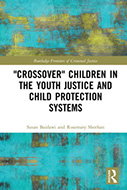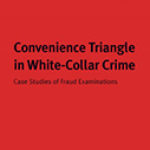“Crossover” Children In The Youth Justice And Child Protection Systems

Authors: Susan Baidawi and Rosemary Sheehan
Publisher: London; New York: Routledge, 2019. 160p.
Reviewer: Denise C. Herz | May 2021
The origin of child welfare and juvenile justice systems in the United States and other Western countries stems from an institutionalized mandate to protect young people from maltreatment, and to rehabilitate those engaged in problem behavior. Although young people in need of system intervention were originally viewed in humanitarian terms, within a short amount of time, the juvenile court system was bifurcated into two systems: one for child victims and one for child offenders or “villains.” Over time, this bifurcation was entrenched in separate philosophies and practices across systems; consequently, when young people served in the child protection system cross into juvenile justice, they often fall into the abyss that separates them. “Crossover” Children in the Youth Justice and Child Protection Systems brings attention to this long-standing problem, and centers our attention on the “care to custody pipeline” occurring in (but not limited to) Australia. With great consistency across Western countries, statistics show children entering child protection systems as victims, and leaving as offenders with worse life outcomes than their counterparts who only experience one system or no system at all.
“Crossover Children” in the Youth Justice and Child Protection Systems coalesces the findings of a two-year study conducted in collaboration with the Children’s Court of Victoria, Australia between 2016 and 2018 into a coherent understanding of the crossover youth experience within and across systems, exposing the limitations of and, at times, the criminogenic impact of the policies and practices enacted by law enforcement, the courts, the child protection system and justice system, education, and the service delivery system. Specifically, the purpose of this exploratory/descriptive study was to further investigate crossover children in the juvenile court to better understand their characteristics and how those characteristics contribute to their entry into and entrenchment in the justice system. Similarly, the study sought to understand these issues from the perspective of professionals who interact with and are responsible for the well-being of these children.
The authors used two sources of data: case file reviews of crossover youth, and focus groups and interviews with system professionals. The sample for case file reviews consisted of 300 young people between 10 and 17 years old, with criminal charges over a period of eleven months (June 2016 through April 2017) who also had a current or historical statutory involvement with child protection services (i.e., substantiated maltreatment). The sample was limited to three so-called Children’s Courts, selected for their diversity in socioeconomic status, culture, and geography (e.g., metropolitan vs. rural). Case files provided a detailed history of the young person’s experiences in both systems, and included reports, assessments, and other agency notes compiled by both the child protection and justice systems. Additionally, 25 focus groups and/or interviews were conducted with 82 professionals, including judges, attorneys, other government agencies, education, and non-government agencies responsible for delivering services to youth and their families. Semi-structured questions focused on the professionals’ perceptions of crossover youth, differences in decision-making, overrepresentation, barriers to serving, success in serving, interagency relationships, and needed policies and practices.
Chapters 1 and 2 provide context for the study and its findings by reviewing what we know about crossover children, and an overview of government and policy developments. What is particularly compelling about the authors’ review of the previous findings as well as current government and policy developments is their consistency within the literature and across jurisdictions. The prevalence of child welfare contact among justice-involved youth as well as the demographic profile of these young people is shockingly similar regardless of place. In various studies across jurisdictions and countries, nearly half or over half of justice-involved populations had some level of involvement with the child welfare system. Additionally, the overrepresentation of children from racial minorities in crossover populations increases regardless of geographic location. In the United States, the overrepresentation of Black children is amplified in crossover populations, and in countries with historic legacies of settler-colonialism, the same holds true for Indigenous populations. Males are overrepresented in crossover populations, but females have a higher rate of being in crossover populations than in justice-only populations.
Such consistent findings reinforce the premise that crossover youth are not a small and specialized population; rather, they are a population often lost between systems who are in need of holistic, child and family-centered, and comprehensive approaches that facilitate and support interagency coordination and collaboration. Despite a growing recognition of these issues, only a few Western countries (e.g., New Zealand and the Nordic countries) have formally adopted a merged model that recognizes an inseparable relationship between child and family needs and the child’s subsequent deeds. Most countries, including the United States and Australia, however, continue to rely on justice systems that are ill-equipped to adequately and effectively deal with trauma, family, and other needs. Promising approaches, however, are beginning to gain traction as more detailed information about crossover children, their experiences, and their pathways grows. The mixed method findings presented in “Crossover Children” contribute to a growing call for action to prevent children in the child protection system from crossing into juvenile justice, and to better serve them if they do, in at least three ways. First, the case file results replicate many previous studies documenting the adversity experienced by crossover children prior to their offending; second, the application of a theoretical framework to the findings captures the crossover experience and identifies ways to interrupt the “care to custody pipeline;” and third, the authors offer important directions for policy, practice, and research.
The findings presented in Chapters 4, 6, and 7 generate a profile of crossover youth including socio-demographics, culture and Indigeneity, and crossover youth offending patterns. Socio-demographic profiles of the youth in “Crossover Children” closely align with those reported in previous studies in the United States, showing high levels of representation for racial minorities (in this case, Indigenous children); increased representation of females; high levels of mental health difficulties, substance abuse, and trauma exposure; and high levels of instability within the family, in living situations and in school engagement. Indigenous children were more likely than non-Indigenous children to touch both systems, and subsequently, they were overrepresented in the crossover population. Most of the children in this study had experienced family violence, and nearly half of these youth had inconsistent or no contact with their parents. Many of these parents suffered from mental illness, substance abuse, and intergenerational trauma, while approximately one-quarter were involved in the criminal justice system. Findings also showed that by the time crossover children reached the Children’s Court, they had been referred to the child protection system numerous times, but these referrals did not always result in a substantiated case. When cases were opened, these children were often placed in out-of-home care, with high levels of residential placement. Educationally, these children were struggling and often failing. Few were engaged in educational programming, and for those enrolled in school, about a third experienced suspensions and/or expulsions. The majority of children had mental health challenges, and even more were using drugs and alcohol often to self-medicate. Crossover youth were also often victims of bullying, and not surprisingly, at high risk for running away and experiencing sexual exploitation.
Offending patterns also replicated previous findings in the literature. Crossover youth had an earlier onset of delinquency and a greater volume of offending compared to their non-crossover counterparts. Charges often involved person offenses or property offenses, and they had high rates of violating court orders. These youth were often living in residential placements and engaged in group offending, reinforcing the influence of peers for youth living in congregate care settings. Their court outcomes were often harsher than those for youth without child protective services care. Even more disturbing, results showed that these patterns were often more substantial for Indigenous crossover youth.
The authors triangulate the profiles of crossover youth with professional perceptions of these children and their system experiences in Chapter 5. Professionals often defined crossover youth as those with high levels of offending and system involvement. Their descriptions of crossover youth matched the data drawn from case files, particularly with regard to the role of adversity and intergenerational trauma. Given their experiences, respondents believed residential placements were particularly problematic for these youth because they combined instability in their living situation with exposure to delinquent peers. From a systems perspective, professional viewpoints confirmed the presence of on-going conflicts and tensions across different agencies caused by fragmented systems, a lack of communication, and a lack of information-sharing. These system failings, they felt, created more adversity for youth and potentially contributed to on-going and escalating offending. Collectively, respondent observations and viewpoints emphasized similar conclusions as those found in the United States: (1) Earlier and more intensive family-centered services are needed to disrupt pathways into offending, and (2) for youth involved in both systems, courts and interagency coordination are essential to serving crossover youth holistically and meeting their needs to prevent future delinquency.
Perhaps the most significant contribution of “Crossover Children” is the authors’ theoretical framing to better understand their findings across case files, focus groups, and interviews. Although previous research has documented similar profiles as those in this Australian sample, a detailed analysis of the role and interplay among trauma, adversity, and situational context has been limited. Viewing the results through the lens of an ecological systems approach alongside attachment and trauma theories produced a more comprehensive understanding of crossover youth and their pathways into offending. In taking this approach, the authors move beyond the characteristics of crossover youth and begin to understand how grief, loss, and trauma—both in their personal lives and as a result of system decision-making—contextualize their experiences and behaviors (Chapter 8). With this in mind, the authors identify cumulative adversity as a key factor in crossing into delinquency. Cumulative adversity that begins with family histories of and exposure to violence, continues into unstable living situations and educational engagement, and is further compounded by differential treatment in and across systems due to perceptions of risk and the influence of situational context on decision-making—i.e., normal adolescent behaviors considered problematic because of their situation created by their involvement in the child protection system. Furthermore, the relationship between cumulative adversity and offending becomes recursive at some point, with one leading to the other and continuing into adulthood.
The contribution of cumulative adversity combined with deeper justice system involvement underscores the imperative to build early prevention systems in the community to prevent maltreatment and delinquency, to enhance services in child protection systems to prevent youth from crossing into delinquency, and to build integrated systems to comprehensively serve youth who enter the juvenile justice system and reduce the time they spend in the system. Particularly important is the need to accomplish all levels of prevention in a culturally informed and appropriate way. Engaging and utilizing services within the communities connected to children, youth, and families is instrumental to building their resilience and minimizing their involvement with these formal systems. Chapter 9 outlines directions and recommendations for addressing these areas and stresses the need for expanding research on crossover youth in many ways, including, but not limited to more fully understanding the pathways that lead to offending and exploring the role of positive relationships in preventing delinquency. In sum, “Crossover” Children in the Youth Justice and Child Protection Systems provides a robust summary of what we know about this population of youth and raises critical questions to spur new directions for research in this area.


